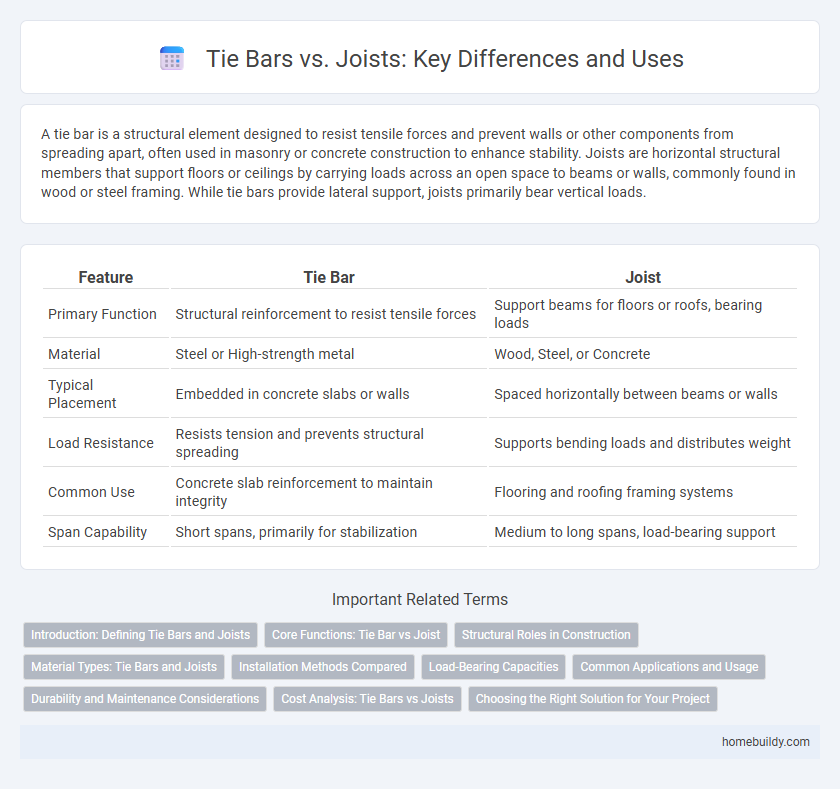A tie bar is a structural element designed to resist tensile forces and prevent walls or other components from spreading apart, often used in masonry or concrete construction to enhance stability. Joists are horizontal structural members that support floors or ceilings by carrying loads across an open space to beams or walls, commonly found in wood or steel framing. While tie bars provide lateral support, joists primarily bear vertical loads.
Table of Comparison
| Feature | Tie Bar | Joist |
|---|---|---|
| Primary Function | Structural reinforcement to resist tensile forces | Support beams for floors or roofs, bearing loads |
| Material | Steel or High-strength metal | Wood, Steel, or Concrete |
| Typical Placement | Embedded in concrete slabs or walls | Spaced horizontally between beams or walls |
| Load Resistance | Resists tension and prevents structural spreading | Supports bending loads and distributes weight |
| Common Use | Concrete slab reinforcement to maintain integrity | Flooring and roofing framing systems |
| Span Capability | Short spans, primarily for stabilization | Medium to long spans, load-bearing support |
Introduction: Defining Tie Bars and Joists
Tie bars are tensile reinforcement elements used in concrete slabs to transfer loads and reduce crack width, enhancing structural integrity. Joists are horizontal structural members designed to support floor or roof loads by distributing weight across beams or walls. Both components play crucial roles in load distribution, but tie bars primarily resist tension while joists carry bending and shear forces.
Core Functions: Tie Bar vs Joist
Tie bars provide lateral support and stability by connecting joists or beams, preventing them from twisting or buckling under load. Joists primarily function as horizontal structural members that support floors or ceilings by carrying the loads directly and distributing weight across beams or walls. While joists bear vertical loads, tie bars maintain structural integrity by resisting lateral forces and ensuring alignment in framing systems.
Structural Roles in Construction
Tie bars primarily function to provide lateral stability and resist tension forces in concrete slabs, preventing cracking and structural deformation. Joists serve as horizontal structural members that support floor or ceiling loads, transferring weight to beams or load-bearing walls. While tie bars enhance the integrity of reinforced concrete by connecting adjacent slabs, joists form the primary framework that supports and distributes loads in building construction.
Material Types: Tie Bars and Joists
Tie bars are commonly made from high-strength steel or stainless steel, providing excellent tensile strength and corrosion resistance for structural stability. Joists are often fabricated from steel, wood, or engineered wood products such as laminated veneer lumber (LVL) and steel joists for greater load-bearing capacity and flexibility in construction design. Understanding the material types helps determine the optimal choice between tie bars and joists based on the specific requirements of building load distribution and environmental conditions.
Installation Methods Compared
Tie bars are installed by embedding them within concrete slabs or fixing them between adjacent slabs to minimize joint movement and provide load transfer, requiring precise alignment and spacing. Joists are typically placed as horizontal structural members supporting floors or roofs, installed through lifting into position and secured with fasteners or welding, emphasizing strength and spacing for load distribution. Compared to joists, tie bars necessitate integration during concrete pouring, demanding coordination with formwork, while joists allow post-fabrication installation flexibility.
Load-Bearing Capacities
Tie bars generally offer higher load-bearing capacities compared to joists, as they are designed to distribute loads evenly across structural elements, enhancing overall stability. Joists primarily support floor or ceiling loads but have limited capacity to handle significant lateral forces or heavy weight distribution. In construction, selecting tie bars over joists is crucial when increased strength and load transfer efficiency are required for structural integrity.
Common Applications and Usage
Tie bars are commonly used in concrete slab reinforcement to control cracking and distribute loads evenly across the slab, primarily in pavements, driveways, and industrial floors. Joists serve as horizontal structural elements providing support for floors and ceilings in residential and commercial buildings, typically made of wood or steel. While tie bars enhance slab integrity by connecting adjoining concrete sections, joists form the core framework that carries vertical loads and supports floor decking.
Durability and Maintenance Considerations
Tie bars provide enhanced durability in construction by offering superior resistance to lateral forces compared to joists, which can experience more wear under stress. Maintenance of tie bars typically requires less frequent inspection and repair due to their robust, simple design, whereas joists often demand regular monitoring for potential cracks or deformation. Choosing tie bars over joists can result in lower long-term maintenance costs and increased structural longevity.
Cost Analysis: Tie Bars vs Joists
Tie bars typically offer a cost-effective solution compared to joists due to lower material and installation expenses, reducing overall project budgets in structural frameworks. Joists, while potentially more expensive upfront, provide enhanced load-bearing capacity and structural support, which can lead to long-term savings by minimizing maintenance and increasing building longevity. Evaluating specific project requirements and load demands is essential for an accurate cost-benefit analysis between tie bars and joists.
Choosing the Right Solution for Your Project
Selecting between a tie bar and a joist depends on the structural requirements and load distribution of your project. Tie bars are ideal for reinforcing concrete slabs by minimizing cracking and controlling shrinkage, while joists provide primary support in frameworks by bearing significant loads across spans. Assessing factors such as span length, load capacity, and installation complexity ensures the right solution for optimal stability and efficiency.
Tie bar vs Joist Infographic

 homebuildy.com
homebuildy.com